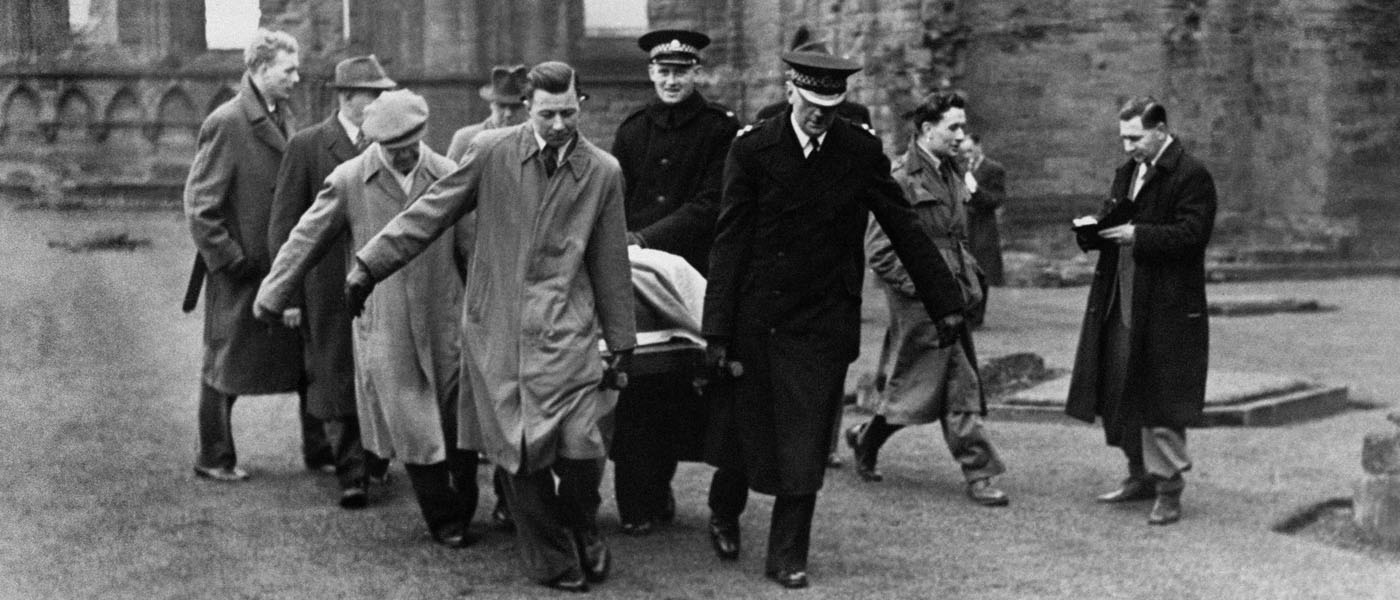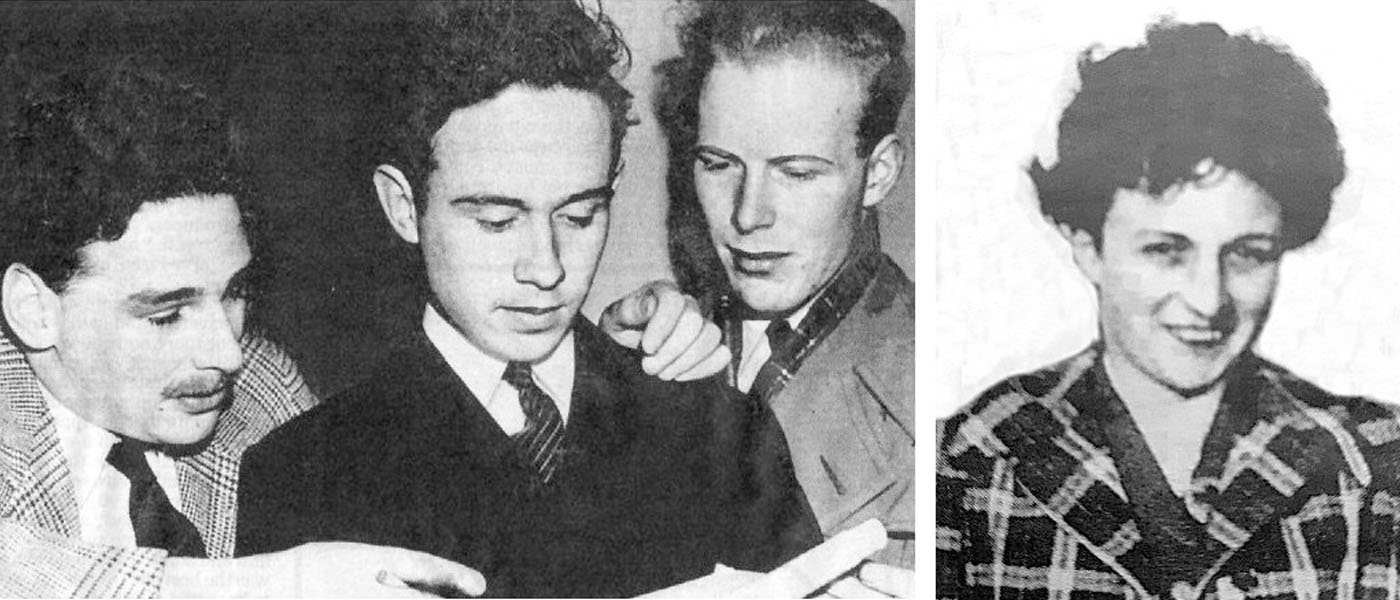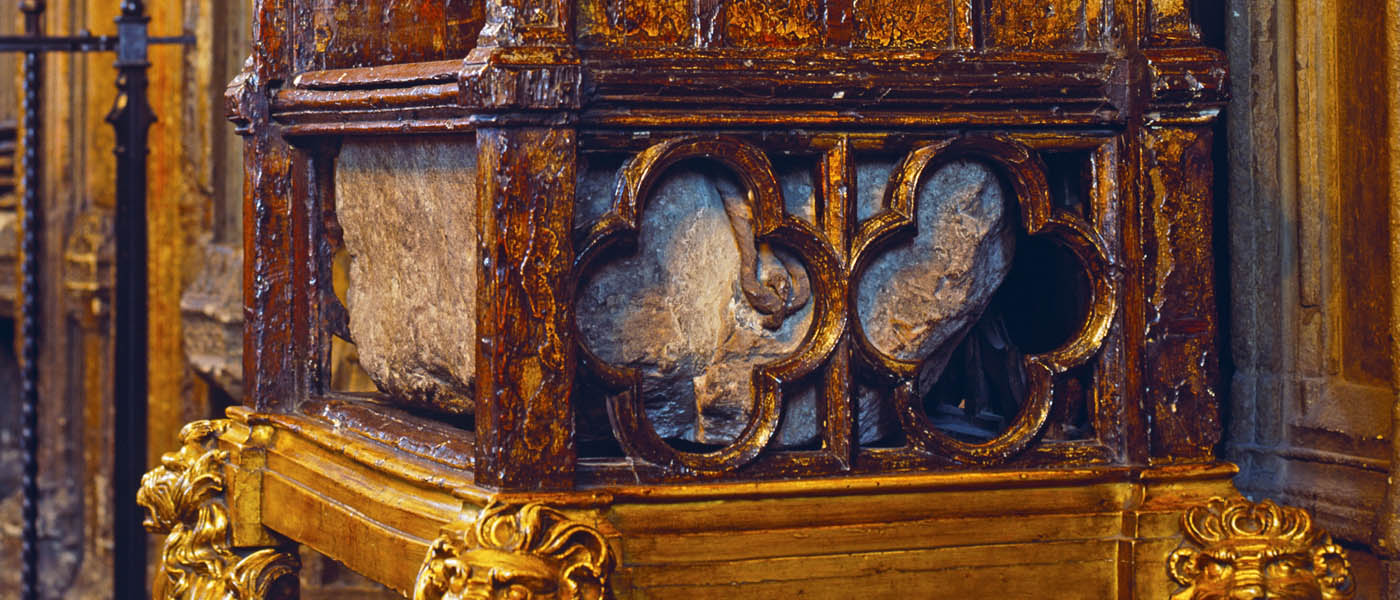
The daring capture of the Stone of Destiny
It’s a story you’d more reasonably associate with Famous Five-type adventure books than the stately halls of Gilmorehill. But a dead-of-night road trip from Glasgow to London at Christmas 1950 to bring home the Stone of Destiny – Scotland’s ancient symbol of monarchy – was the work of four Glasgow students, the last of whom, Ian Hamilton KC (BL 1952), has recently died. BBC Scotland's Steven Brocklehurst looks back on the epic tale.
When a passing policeman saw a couple in a passionate embrace in a car outside Westminster Abbey, he did not for a moment consider they might be in the midst of one of the most audacious heists in British history. The man in the car was Ian Hamilton who, back in 1950, was a 25-year-old UofG student who was in London intent on making a massive statement about Scottish nationalism.

The four student co-conspirators who took the Stone of Destiny from Westminster Abbey in 1950. Left to right: Gavin Vernon, Ian Hamilton, Alan Stuart and Kay Matheson. (Photos: Glasgow Police Museum)
The policeman had seen him jump into the Ford Anglia beside fellow student Kay Matheson and had gone to investigate why they were parked in front of the Abbey in the early hours of Christmas Day. The cuddling couple explained that they had just arrived from Scotland and could not find a hotel. The sympathetic policeman chatted to them before saying they would need to move on.
As he watched them drive away, he was unaware that concealed in the car was a broken chunk of the Stone of Destiny, the ancient symbol of Scotland, which had been seized six centuries earlier by English King Edward I. Before the night was over, Ian Hamilton had snatched the other part of the 150kg (336lb) red sandstone block and spirited it away from the Abbey.
The Stone of Destiny, also known as the Stone of Scone, was used in the coronation of Scottish kings for hundreds of years before it was looted during the Wars of Independence and taken to Westminster Abbey to sit within King Edward's carved-oak coronation throne.
"The Stone of Destiny is Scotland's icon. To bring it back was a very symbolic gesture.” Ian Hamilton
in 1950, during the Christmas holidays from university, the four students set off for London in two elderly Ford cars. The other members of the gang were Gavin Vernon and Alan Stuart.
Their first plan was for Ian to slip into a dark corner of the Abbey just before it closed for the night and later open the door from the inside. But the night watchman caught sight of him and threw him out, accepting the excuse that he had been locked in by accident.
The next night they tried again. By 4am, they had parked one of the cars nearby and driven the other right up the lane behind Westminster Abbey. While Kay waited in the car, the men went up to the Poets’ Corner door to try to jemmy it open. Kay later said she was sure the noise could be heard on the other side of London.
Having managed to break open the door, the group set about removing the stone from its cavity beneath the throne. They placed the stone on the floor and Ian took his coat off so they could use it to drag the block along. They each took an arm of the coat and Ian took hold of one of the chains attached to the stone – but as soon as he pulled, the stone gave way and broke in two. In shock, Ian said he picked up the smaller bit of stone, weighing about 90lbs (40kg), and ran with it as if it was a rugby ball.
Kay said she saw him coming out the side door of the Abbey. "Then, to my horror, I saw this policeman looking down the lane," she said. "I realised if Ian crossed over to the car with the stone, the policeman was bound to see him. So I drew the car in as closely as I could and Ian quickly pushed the stone into the back seat of the car and threw a coat over it."
After the encounter with the policeman, Kay and Ian set off with the smaller of the two pieces in the back of their Ford Anglia. Gavin and Alan fled without the larger section, thinking they had been abandoned. They did not know that Ian had got out of the car and was now making his way back to the Abbey. The keys to the second car had fallen out of his coat pocket, so he had to go back inside the pitch-black church to find them, which luckily he did. It was now left to Ian to single-handedly manhandle the larger section of the stone into the boot of the car.

The Stone of Destiny in the coronation chair in Westminster Abbey. Photo: Alamy
Ian drove away from the Abbey just as dawn was breaking, and by chance discovered Gavin and Alan plodding along looking lost near the Old Kent Road. The gang buried the large section of the stone in open country near Rochester in Kent. Kay had left the smaller piece at a friend's house, and it lay in a garage in Birmingham.
When the stone was discovered to be missing, it caused an international sensation and the border between Scotland and England was closed off for the first time in 400 years. The Metropolitan Police had assumed the stone was heading north of the border, so a team of Scotland Yard detectives were sent to work with Scottish police.
Ian said he had intended to leave the stone buried until the hue and cry had died down, but became worried about the effect of the freezing conditions on a stone that had not been exposed to the elements for 600 years, so on Hogmanay (New Year's Eve), he set off with Alan and two others to retrieve the larger section from Kent. When they got to Rochester, they found a traveller encampment on top of the stone but managed to talk them into helping carry it to the car.
Finally, when they got back to Scotland, the stone was handed over to other members of the Scottish Covenant Association, who were campaigning for a Scottish Parliament. Ian was glad to get rid of it as suspicion was already falling on him.
Detectives investigating the disappearance of the Stone of Destiny discovered that Ian had taken out nearly every book in Glasgow's Mitchell Library on the subject of the stone in the months before it was taken.
By now, the main part of the stone was hidden under the floorboards at a factory in Bonnybridge and the second section was brought up from Birmingham. The two were eventually put back together by a stonemason using copper tube dowelling.
After a few months, the Scottish Covenant Association decided the stone should be returned. The heist had served its purpose of publicising the cause of Scottish home rule so they decided to leave the stone at the ruined abbey of Arbroath, where a famous statement of Scottish independence was made in 1320.
On 11 April 1951, the stone was taken back to London and returned to Westminster Abbey. It was replaced in the Coronation Chair and two years later, in June 1953, the stone had a greater prominence than ever when the coronation of Queen Elizabeth II was broadcast on television.
The Home Secretary made a statement to the House of Commons: "It was known who had done it, but it would not be in the public interest to prosecute the vulgar vandals."
Forty years later, in July 1996, the Queen, along with Prime Minister John Major, agreed the stone should be returned to Scotland. It can now be seen at Edinburgh Castle, but will temporarily return to Westminster Abbey in May 2023 for the coronation of King Charles III in 2023.
The student gang were never prosecuted for their actions. No-one had been harmed, the government said, even if the stone had a bumpy ride.
"To do something for your country that spills not a drop of blood,” said Ian Hamilton, “is, I think, something to be proud of."
This article was first published by BBC Scotland News in October 2022.
Return to Avenue homepage
The gang of four
- Ian Hamilton KC, the mastermind of the intrepid foursome, went on to have a successful career in criminal law and wrote two books about the taking of the Stone. He died in October 2022.
- Kay Matheson studied at the 'Dough School' in Domestic Science teaching, after which she returned to Inverasdale in the west Highlands. She was a teacher in the local primary school, and died in 2013.
- Gavin Vernon (BSc 1952) graduated in electrical engineering and emigrated to Canada in the 1960s, famously remarking that he “never had to buy a beer again” any time he returned to his homeland. He died in March 2004.
- Alan Stuart (BSc 1953) had a successful business career in Glasgow and died, aged 88, in 2019.

